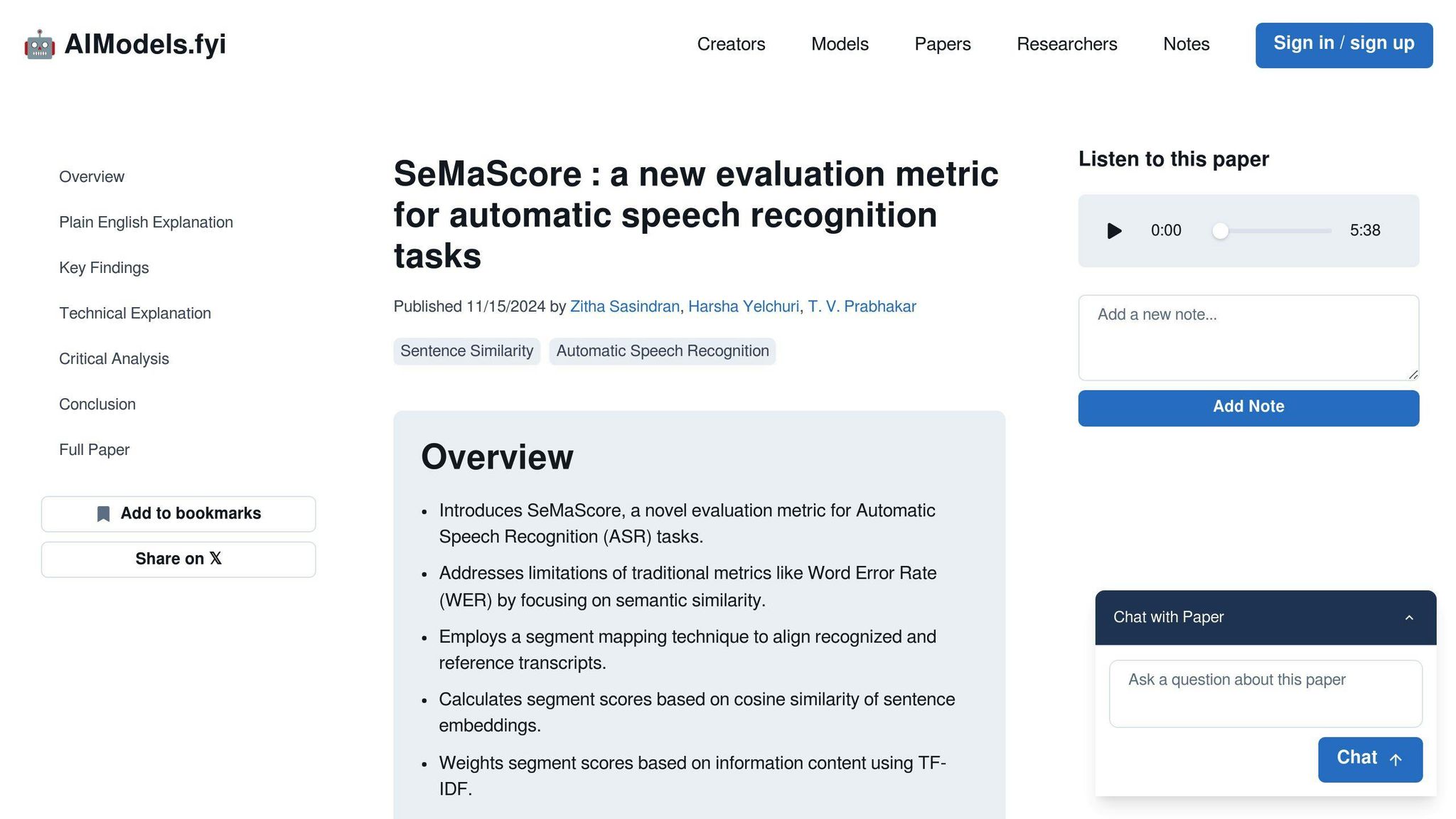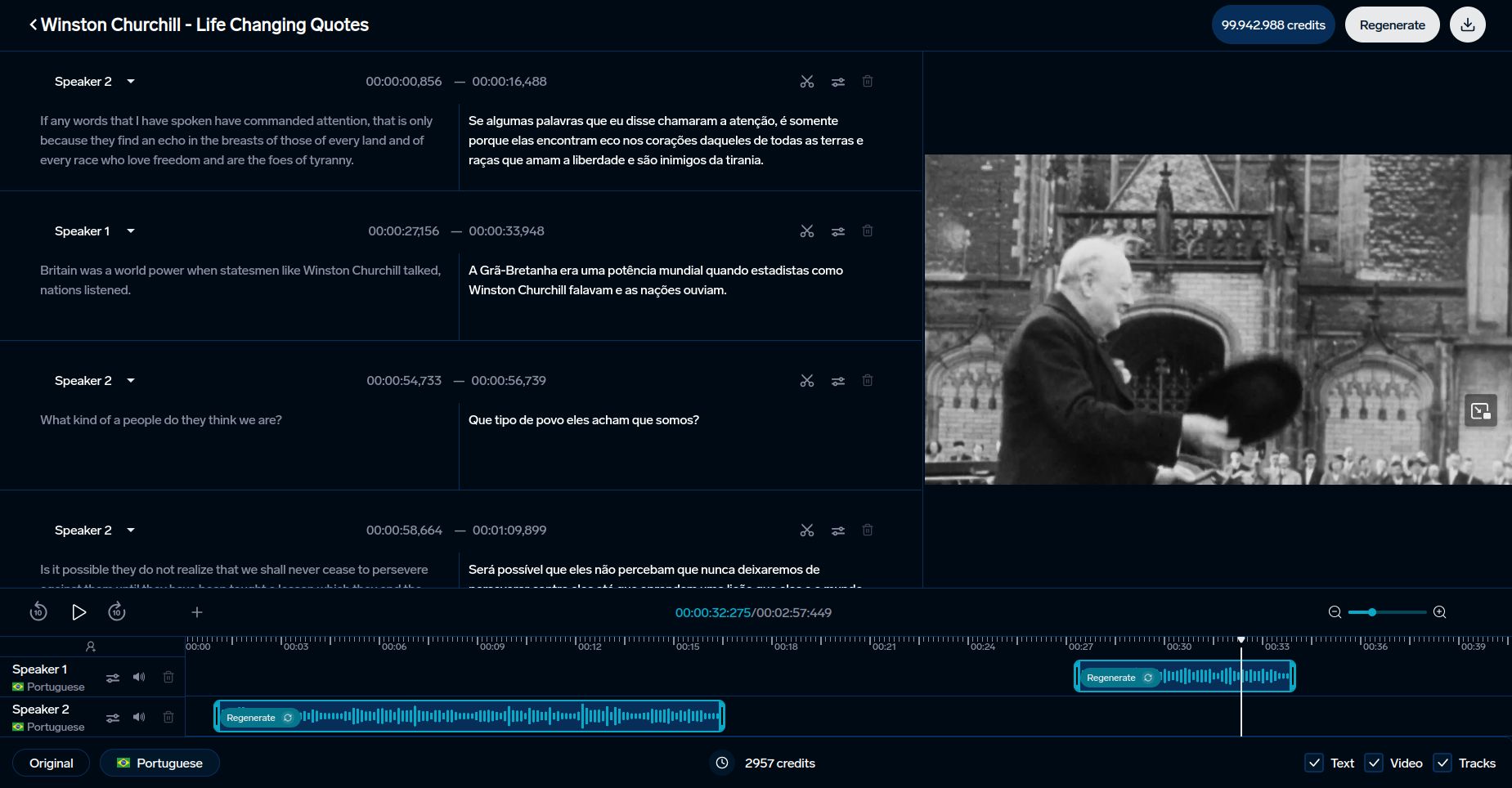Evaluation Metrics for Speech Recognition Models
Speech recognition models are judged by how accurately they transcribe speech and retain meaning across different conditions. The three main metrics used are:
- Word Error Rate (WER): Measures transcription errors (insertions, deletions, substitutions). Best for clean audio but struggles with noise or accents.
- Character Error Rate (CER): Tracks character-level accuracy, ideal for languages like Chinese or Japanese.
- SeMaScore: Focuses on semantic meaning, performing well in noisy environments and with diverse accents.
Quick Comparison of Metrics
| Metric | Focus | Best For | Limitations |
|---|---|---|---|
| WER | Word-level accuracy | Clean speech | Struggles with noise/accents |
| CER | Character-level accuracy | Asian languages | No semantic understanding |
| SeMaScore | Semantic meaning retention | Noisy, multilingual audio | Higher computational demand |
Advanced methods like acoustic and unified modeling further enhance evaluations by simulating real-world conditions. These metrics are crucial for improving tools like multilingual transcription platforms.
Key Metrics for Evaluating Speech Recognition
Speech recognition models use specific metrics to gauge how well they perform. These metrics help developers and researchers understand how effective their Automatic Speech Recognition (ASR) systems are in various conditions and languages.
Word Error Rate (WER)
Word Error Rate (WER) is one of the most widely used metrics for measuring how accurately a system transcribes speech. It identifies errors in three categories:
- Insertions: Words added that shouldn’t be there.
- Deletions: Words that are missing from the transcription.
- Substitutions: Incorrect words replacing the correct ones.
The goal is to achieve a lower WER, as it reflects better accuracy. That said, WER can have drawbacks, especially in situations with background noise or unusual speech patterns.
Character Error Rate (CER)
Character Error Rate (CER) offers a more detailed analysis by focusing on individual characters rather than entire words. This makes it especially useful for languages like Chinese or Japanese, where characters carry significant meaning.
CER is particularly effective for multilingual systems or cases where word boundaries are unclear. While it provides a detailed linguistic analysis, newer metrics such as SeMaScore aim to address broader challenges related to meaning.
SeMaScore

SeMaScore goes beyond traditional metrics like WER and CER by incorporating a semantic layer into the evaluation process. It measures how well the system retains the intended meaning, not just the exact words or characters.
Here’s how SeMaScore stands out in specific scenarios:
| Scenario Type | How SeMaScore Helps |
|---|---|
| Noisy Environment | Matches human perception in noisy settings |
| Atypical Speech | Aligns with expert evaluations of meaning |
| Complex Dialects | Preserves semantic accuracy across dialects |
SeMaScore is particularly useful for assessing ASR systems in challenging conditions, providing a broader and more meaningful evaluation of their performance. Together, these metrics offer a well-rounded framework for understanding how ASR systems perform in different situations.
Advanced Methods for Evaluating ASR Models
The process of evaluating Automatic Speech Recognition (ASR) models has moved beyond basic metrics, using more advanced techniques to gain deeper insights into how these systems perform.
The Role of Acoustic Modeling
Acoustic modeling connects audio signals to linguistic units by using statistical representations of speech features. Its role in ASR evaluation depends on several technical factors:
| Factor | Effect on Evaluation |
|---|---|
| Sampling Rate & Bits per Sample | Higher values improve recognition accuracy but can slow processing and increase model size |
| Environmental Noise & Speech Variations | Makes recognition harder; models need testing with diverse and challenging data |
Acoustic models are designed to handle a variety of speech patterns and environmental challenges, which are often missed by traditional evaluation metrics.
Unified Modeling in ASR
Unlike acoustic modeling, which focuses on specific speech features, unified modeling combines multiple recognition tasks into a single framework. This approach improves ASR evaluation by reflecting real-world use cases, where systems often handle multiple tasks at once.
Important factors for evaluation include:
- Balancing speed with accuracy
- Maintaining performance under heavy usage
- Ensuring consistent results across different environments
Platforms like DubSmart use these advanced techniques to enhance speech recognition for multilingual content and voice cloning.
These methods provide a foundation for comparing different evaluation metrics, shedding light on their advantages and limitations.
Applications and Challenges of Evaluation Metrics
Evaluation metrics play a critical role in improving tools like DubSmart and tackling ongoing hurdles in automatic speech recognition (ASR) systems.
Use in AI Tools like DubSmart

Speech recognition metrics are essential for enhancing AI-driven language tools. DubSmart leverages these metrics to deliver multilingual dubbing and transcription services across 33 languages. The platform integrates both traditional and advanced metrics to ensure quality:
| Metric | Application | Impact |
|---|---|---|
| SeMaScore | Multilingual and Noisy Environments | Preserves semantic accuracy and meaning retention |
This combination ensures high precision, even in challenging scenarios like processing multiple speakers or handling complex audio. Semantic accuracy is especially important for tasks such as voice cloning and generating multilingual content.
Challenges in ASR Evaluation
Traditional evaluation methods often fall short when dealing with accents, background noise, or dialect variations. Advanced tools like SeMaScore address these gaps by incorporating semantic-based analysis. SeMaScore, in particular, marks progress by blending error rate evaluation with deeper semantic understanding.
"Evaluating speech recognition requires balancing accuracy, speed, and adaptability across languages, accents, and environments."
To improve ASR evaluation, several factors come into play:
- Enhancing acoustic models to achieve a balance between precision and efficiency
- Meeting real-time processing needs without compromising accuracy
- Ensuring consistent performance across varied contexts
Newer evaluation techniques aim to provide more detailed insights into ASR performance, especially in demanding situations. These advancements help refine tools for better system comparisons and overall effectiveness.
sbb-itb-f4517a0
Comparison of Evaluation Metrics
Evaluating speech recognition systems often comes down to choosing the right metric. Each one highlights different aspects of performance, making it crucial to match the metric to the specific use case.
While WER (Word Error Rate) and CER (Character Error Rate) are well-established, newer options like SeMaScore provide a broader perspective. Here's how they stack up:
Metrics Comparison Table
| Metric | Accuracy Performance | Semantic Understanding | Use Case Scenarios | Processing Speed | Computational Demands |
|---|---|---|---|---|---|
| WER | High for clean speech, struggles with noise | Limited semantic context | Standard ASR evaluation, clean audio | Very fast | Minimal |
| CER | Great for character-level analysis | No semantic analysis | Asian languages, phonetic evaluation | Fast | Low |
| SeMaScore | Strong across varied conditions | High semantic correlation | Multi-accent, noisy environments | Moderate | Medium to high |
WER works well in clean audio scenarios but struggles with noisy or accented speech due to its lack of semantic depth. On the other hand, SeMaScore bridges that gap by combining error analysis with semantic understanding, making it a better fit for diverse and challenging speech conditions.
As tools like DubSmart integrate ASR systems into multilingual transcription and voice cloning, selecting the right metric becomes critical. Research shows SeMaScore performs better in noisy or complex environments, offering a more reliable evaluation.
Ultimately, the choice depends on factors like the complexity of the speech, the diversity of accents, and available resources. WER and CER are great for simpler tasks, while SeMaScore is better for more nuanced assessments, reflecting a shift toward metrics that align more closely with human interpretation.
These comparisons show how ASR evaluation is evolving, shaping the tools and systems that rely on these technologies.
Conclusion
The comparison of metrics highlights how ASR evaluation has grown and where it's headed. Metrics have adapted to meet the demands of increasingly complex ASR systems. While Word Error Rate (WER) and Character Error Rate (CER) remain key benchmarks, newer measures like SeMaScore reflect a focus on combining semantic understanding with traditional error analysis.
SeMaScore offers a balance of speed and precision, making it a strong choice for practical applications. Modern ASR systems, such as those used by platforms like DubSmart, must navigate challenging real-world scenarios, including diverse acoustic conditions and multilingual needs. For instance, DubSmart supports speech recognition in 70 languages, demonstrating the necessity of advanced evaluation methods. These metrics not only improve system accuracy but also enhance their ability to handle varied linguistic and acoustic challenges.
Looking ahead, future metrics are expected to combine error analysis with a deeper understanding of meaning. As speech recognition technology progresses, evaluation methods must rise to the challenge of noisy environments, varied accents, and intricate speech patterns. This shift will influence how companies design and implement ASR systems, prioritizing metrics that assess both accuracy and comprehension.
Selecting the appropriate metric is crucial, whether for clean audio or complex multilingual scenarios. As ASR technology continues to advance, these evolving metrics will play a key role in shaping systems that better meet human communication needs.
FAQs
What metric is used to evaluate speech recognition programs?
The main metric for evaluating Automatic Speech Recognition (ASR) systems is Word Error Rate (WER). It calculates transcription accuracy by comparing the number of errors (insertions, deletions, and substitutions) to the total words in the original transcript. Another method, SeMaScore, focuses on semantic evaluation, offering better insights in challenging scenarios, such as accented or noisy speech.
How do you evaluate an ASR model?
Evaluating an ASR model involves using a mix of metrics to measure both transcription accuracy and how well the meaning is retained. This ensures the system performs reliably in various situations.
| Evaluation Component | Description | Best Practice |
|---|---|---|
| Word Error Rate (WER) | Tracks word-level accuracy compared to human transcripts | Calculate the ratio of errors (insertions, deletions, substitutions) to total words |
| Character Error Rate (CER) | Focuses on accuracy at the character level | Best for languages like Chinese or Japanese |
| Semantic Understanding | Checks if the meaning is preserved | Use SeMaScore for deeper semantic evaluation |
| Real-world Testing | Evaluates performance in diverse settings (e.g., noisy, multilingual) | Test in various acoustic environments |
"ASR evaluation has traditionally relied on error-based metrics".
When assessing ASR models, consider these practical factors alongside accuracy metrics:
- Performance in different sound environments
- Handling of accents and dialects
- Real-time processing ability
- Robustness against background noise
Tailor the evaluation process to your specific application while adhering to industry standards. For example, platforms like DubSmart emphasize semantic accuracy for multilingual content, making these evaluation methods especially relevant.
